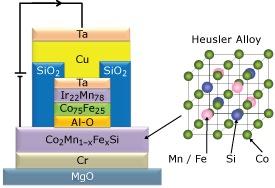

11/30/2009

Controlling electron spin, in addition to the use of electrons as a charge carrier, may one day lead to a new generation of advanced electronic devices. For example, we can envisage transistors based on currents with a well-defined spin orientation, or logic devices in which the magnetization is controlled through electrical currents.
Essential for the development of such ‘spintronic’ devices are materials with suitable magnetic properties, such as a high degree of spin polarization and a high Curie temperature (TC) — the temperature above which the material ceases to be a ferromagnet. These criteria are satisfied by several intermetallic compounds with a specific crystal structure known as Heusler alloys. Terunobu Miyazaki and colleagues at the Advanced Institute for Materials Research (AIMR) and the Department of Applied Physics at Tohoku University1 have now constructed high-performance devices based on Heusler alloys with the composition Co2FexMn1–xSi.
The iron-free alloy Co2MnSi has a high TC (985 K) and is a half-metal; that is, a material in which electrons are conducting if their spin is one direction, and non-conducting if the spin is in the opposite direction, which is ideal for the injection of spin-polarized electrons. The manganese-free alloy Co2FeSi, on the other hand, has an even higher TC (1,150 K), but its status as a half-metal is ambiguous. The team from Tohoku University showed that certain mixtures of these two alloys, with a mixed iron/manganese composition, have a Curie temperature higher than 985 K but retain the half-metal character of Co2MnSi.
The team studied magnetic tunnel junctions consisting of two magnetic electrodes and a tunneling barrier, where one of the electrodes was made of the Co2FexMn1–xSi Heusler alloy (Fig. 1). They looked at how the tunnel magnetoresistance (TMR) — the resistance due to electrons tunneling from the Co2FexMn1–xSi through the barrier in a magnetic field — changed when they varied the amounts of iron and manganese in the alloy. The TMR first increased with the addition of iron, from 67% at x = 0 to a maximum of 75% for compositions between x = 0.4 and x = 0.6, but then dropped to 46% at x = 1. The researchers suggest that the high iron content (high x) causes the compound to stop being a half-metal and the tunneling electrons to become less polarized.
The team also measured the ‘Gilbert damping constant’ of their Co2FexMn1–xSi compounds. This parameter, related to the relaxation of magnetization, should be low for materials used in magnetization switching. They obtained the minimum value for the alloy with a composition of x = 0.4, which also indicates that the material with this iron content is still a half-metal.
Shigemi Mizukami from the research team explains that “engineering of the half-metallicity and damping properties for these alloys is required for actual device design.” In his view, the results of their work on Co2FexMn1–xSi will stimulate further experimentation to obtain Heusler alloys with even higher spin-polarization and lower damping in the near future.
Kubota, T., Tsunegi, S., Oogane, M., Mizukami, S., Miyazaki, T., Naganuma, H. & Ando, Y. Half-metallicity and Gilbert damping constant in Co2FexMn1−xSi Heusler alloys depending on the film composition. Applied Physics Letters 94, 122504 (2009). | article
This research highlight has been approved by the authors of the original article and all information and data contained within has been provided by said authors.